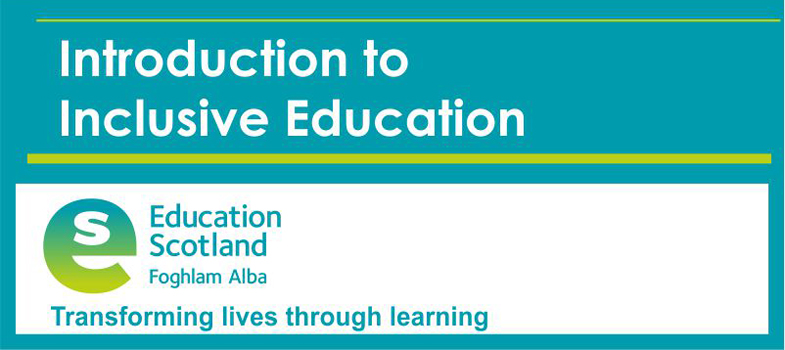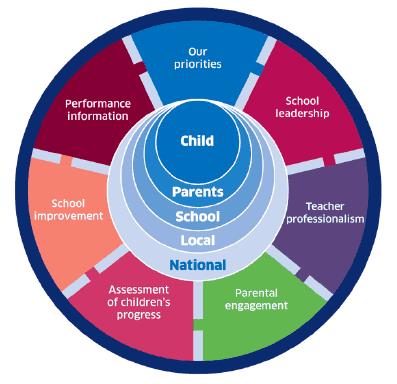Policies supporting inclusive education
Curriculum for Excellence
Curriculum for Excellence is designed to achieve a transformation in education in Scotland by providing a coherent, more flexible and enriched curriculum from 3 to 18. The term curriculum is understood to mean - everything that is planned for children and young people throughout their education, not just what happens in the classroom.
Curriculum for Excellence includes four contexts for learning:
- Curriculum areas and subjects
- Interdisciplinary learning
- Ethos and life of the school
- Opportunities for personal achievement.
Curriculum for Excellence is intended to help children and young people gain the knowledge, skills and attributes needed for life in the 21st century, including skills for learning, life and work
Delivery of the curriculum is the responsibility of education authorities and individual schools under guidance from the Scottish Government and Education Scotland.
Further information on Curriculum for Excellence is available in section 2.4
The 2012 Doran Review Report - ‘The Right Help at the Right Time and Right Place’.
The Doran Review Report sets out the strategic vision for provision for children and young people with complex additional support needs in Scotland. This review underlined that ‘Every child has the right to become a successful learner, confident individual, effective contributor and responsible citizen- wherever their learning is taking place. Some will face barriers to learning and will need additional support to enable them to make the most of their educational opportunities and to realise their potential’. The review report sets out the findings and recommendations for provision across four themed areas;
- Culture, Complex Additional Support Needs and Expertise,
- Policy Choice and Learning Experiences,
- Interagency Working, Planning and Review, and
- National and Local Provision and the Role of the Scottish Government.
Further information on the Doran review can be found here.
The National Improvement Framework (NIF)
The National Improvement Framework (NIF) was introduced in the Education (Scotland) Act 2016 and sets out the vision and priorities for children’s progress in learning in Scotland. It aims to improve Scottish education and close the attainment gap, delivering both excellence and equity. This includes improving and raising the attainment of learners from lower socio-economic backgrounds and extending the rights of learners with additional support needs and the National Improvement Hub has been developed to support this. Figure 4 sets out the drivers which will be analysed to identify where we can make improvements.
Further information on the National Improvement Framework can be found at
https://beta.gov.scot/ publications/ national-improvement-framework-drivers-of-improvement/
Initiatives such as the Scottish Attainment Challenge and the Pupil Equity Fund have also sought to close the poverty-related attainment gap and empower schools to help those children and young people who most need support.
Scottish Attainment Challenge
The Scottish Attainment Challenge is about achieving equality and equity focusing on closing the poverty related attainment gap. It focuses on accelerated targeted improvement activity in literacy, numeracy and health and wellbeing. There is a known correlation between poverty and learners with additional support needs so proven methodologies which help raise attainment of learners will help close poverty related attainment gaps.
Pupil Equity Funding
Pupil Equity Funding is additional funding allocated directly to schools and targeted at closing the poverty-related attainment gap. The Scottish Government has committed to this funding as part of the Scottish Attainment Challenge programme from 2017/18. The Pupil Equity Funding forms part of the £750m Attainment Scotland Fund which will be invested over the current Parliamentary term. Every council area is benefitting from Pupil Equity Funding. Allocations are based on the number of pupils from P1 to S3 who are eligible and registered for free school meals, with schools receiving around £1,200 per pupil. Headteachers work in partnership with each other, and their local authority, to agree the use of the funding.
Activity 2 Reflective Task
In your Reflective Log consider the following questions
- Which Acts of legislation and policies were you aware of?
- What impact has the legislation and policy highlighted in section 1 had on your practice?
Activity 3
Match the legislation or policy with the correct summary.
| Legislation and policy | |
| The United Nations Convention on the Rights of the Child (UNCRC). | |
| The Standards in Scotland’s Schools etc. Act (2000). | |
| Disability Strategies and Pupils’ Educational Records (2002); | |
| Additional Support for Learning (Scotland) Act 2004 (as amended 2009); | |
| Code of Practice to support the ASL ACT | |
| Equality Act (2010); | |
| Children and Young People Act (2014); and | |
| Education (Scotland) (2016). | |
| The Getting it right for every child approach | |
| Curriculum for Excellence | |
| The 2012 Doran Review Report | |
| The National Improvement Framework (NIF) | |
| Scottish Attainment Challenge | |
| Pupil Equity Funding |
| Legislation and Policy Summaries | |
| A | Local authorities, with their partners, have a duty within the Act to ensure that ‘education is directed to the development of personality, talents and mental and physical abilities of the child or young person to their fullest potential.’ |
| B | Provides the legal framework for identifying and addressing the additional support needs of children and young people who face a barrier, or barriers, to learning |
| C | Places a duty on local authorities and schools to ensure the wellbeing of children and young people is safeguarded, supported and promoted. |
| D | Purpose is to ensure an inter-agency approach across education, health and social work to improve outcomes for children and young people. |
| E | Additional funding allocated directly to schools and targeted at closing the poverty-related attainment gap |
| F | Is intended to help children and young people gain the knowledge, skills and attributes needed for life in the 21st century, including skills for learning, life and work. |
| G | Sets out the strategic vision for provision for children and young people with complex additional support needs in Scotland. |
| H | Aims to achieve equality and equity focusing on closing the poverty related attainment gap |
| I | Aims to improve Scottish education and close the attainment gap, delivering both excellence and equity. |
| J | Requires Responsible bodies to develop and publish an accessibility strategy. |
| K | Introduces measures to improve Scottish education and reduce pupil’s inequality of outcomes. |
| L | Places a duty on schools and Education Authorities to eliminate unlawful discrimination, harassment and victimisation of learners with protected characteristics and to actively promote equality of opportunity. |
| M | Designed to help schools, parents and others to understand the ASL Act and ensure its implementation |
| O | A legally-binding international agreement setting out the civil, political, economic, social and cultural rights of every child, regardless of their race, religion or abilities. |
Click reveal to see the correct answers
Answer
| Correct Answers | ||
| Legislation and policy | Summary | |
| The United Nations Convention on the Rights of the Child (UNCRC). | O | A legally-binding international agreement setting out the civil, political, economic, social and cultural rights of every child, regardless of their race, religion or abilities |
The Standards in Scotland’s Schools etc. Act (2000).
| A | Local authorities, with their partners, have a duty within the Act to ensure that ‘education is directed to the development of personality, talents and mental and physical abilities of the child or young person to their fullest potential.’ |
| Disability Strategies and Pupils’ Educational Records (2002); | J | Requires (Responsible bodies) to develop and publish an accessibility strategy. |
| Additional Support for Learning (Scotland) Act 2004 (as amended 2009); | B | Provides the legal framework for identifying and addressing the additional support needs of children and young people who face a barrier, or barriers, to learning |
Code of Practice to support the ASL ACT
| M | Designed to help schools, parents and others to understand the ASL Act and ensure its implementation |
| Equality Act (2010); | L | Places a duty on schools and Education Authorities to eliminate unlawful discrimination, harassment and victimisation of learners with protected characteristics and to actively promote equality of opportunity. |
| Children and Young People Act (2014); and | C | Places a duty on local authorities and schools to ensure the wellbeing of children and young people is safeguarded, supported and promoted. |
| Education (Scotland) (2016). | K | Introduces measures to improve Scottish education and reduce pupil’s inequality of outcomes. |
| The Getting it right for every child approach | D | Purpose is to ensure an inter-agency approach across education, health and social work to improve outcomes for children and young people. |
Curriculum for Excellence
| F | Is intended to help children and young people gain the knowledge, skills and attributes needed for life in the 21st century, including skills for learning, life and work |
| The 2012 Doran Review Report | G | Sets out the strategic vision for provision for children and young people with complex additional support needs in Scotland. |
The National Improvement Framework (NIF)
| I | Aims to improve Scottish education and close the attainment gap, delivering both excellence and equity. |
| Scottish Attainment Challenge | H | Aims to achieve equality and equity focusing on closing the poverty related attainment gap |
Pupil Equity Funding
| E | Additional funding allocated directly to schools and targeted at closing the poverty related attainment gap |
1.2 Key Milestones on the Journey to Inclusion

